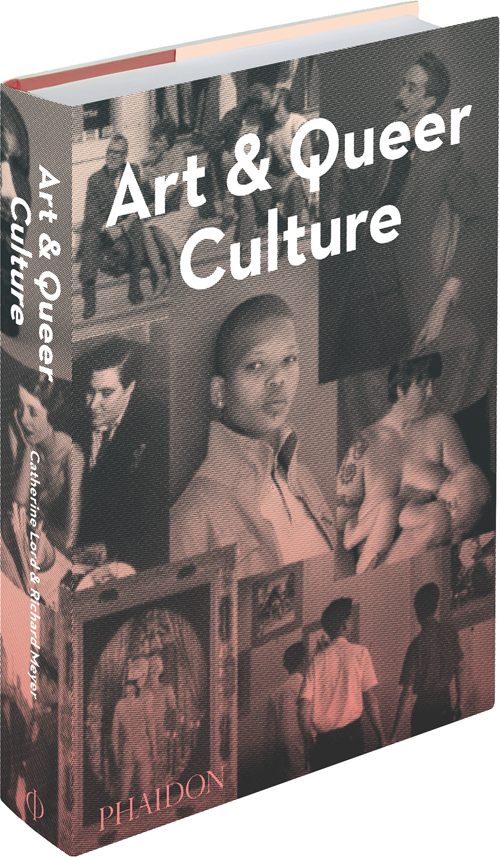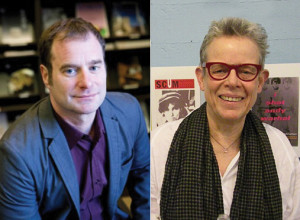
‘Art & Queer Culture’
 Art, semiotics, and gay social development
Art, semiotics, and gay social development
by Kit van Cleave
Catherine Lord and Richard Mayer have made a significant contribution to the constantly changing world of images in their Art & Queer Culture, recently published by Phaidon Press. This huge book is more than the usual coffee-table offering, given its emphasis on the development of artists supporting, even expanding, the work of activists in various segments of the gay community.
As Meyer explains in his introduction, “queer” has been developed as a word of resistance to conformity on several levels. “Attempts to trouble the conventions of gender and sexuality, to highlight the performative aspects of identity, and to oppose the tyranny of ‘the normal’ are woven into the historical fabric of homosexuality and its representation,” he points out.
The book is divided into two sections—one, on white paper, includes essays by Meyer (“Inverted Histories 1885–1979”) and Lord (“Inside the Body Politic 1980–present”). Following these two are 200 pages of full-color illustrations; each one has a mini-essay detailing the importance of that work in the context of politics and human rights of the last century and a quarter.
The second half of the book is printed on orange paper with a typewriter font, and covers a wide variety of historical moments. It begins with the attack in April 1895 by Edward Carson, defense attorney for the Marquis of Queensberry, on a testifying Oscar Wilde, who had sued Queensberry for leaving at Wilde’s club a note calling the author a sodomite. With contempt for the Marquis and arrogance developed from his fame and popularity, Wilde eventually defeated himself before the court.
The orange section ends with Billy Miller’s “The Towers of Cum and Horndogs of Yore” (2011) and Wu Tsang’s Whitney Biennial catalogue essay (2012). In between are essays and journal entries, published essays, and random thoughts by many writers, including Magnus Hirschfeld, Djuna Barnes, Colette, Laura Doan, Sigmund Freud, Norman Mailer, Lorraine Hansberry, Susan Sontag, Andy Warhol, Valerie Solanas, and Monique Wittig. Laura Cottingham’s analyzes Judy Chicago’s “Dinner Party” and its “vulvar plates” through the uneasy relationship between lesbianism and the feminist movement.
Meyer’s essay discusses the beginning of the contemporary gay art scene by German aristocrat Baron Wilhelm von Gloeden, who “restaged classical homoeroticism in his photographs of toga-clad (and unclad) adolescent boys and young men in the 1890s.” Collected by Wilde, German industrialist Friedrich Krupp, and sexologist Alfred Kinsey, these photographs reveal a gay sensibility of the late 19th century.

Meanwhile, painter Marie Laurencin in Paris and artist Jeanne Mammen in Berlin created illustrations for The Songs of Bilitis. Also in Berlin, physician Magnus Hirshfeld was becoming a leading advocate for homosexual rights, founding the Scientific Humanitarian Committee in l897; its purpose was to overturn Paragraph 175, the German law that criminalized homosexuality. Hirschfeld’s 1931 book, Moral History of the Postwar Period, included illustrations of social and sexual life of the period, and helped the career of Mammen, who painted the women’s bars and lesbian nightclubs of Berlin.
Hirschfeld’s Institute of Sexology also provided an important blueprint for post-war research on human sexuality, particularly that of Kinsey and his staff at the Institute of Sex Research in Bloomington, Indiana. Kinsey’s bestselling book of 1847 on the sexual behavior of males, followed by one on women in l953, “demonstrated that homosexuality was far more prevalent within American culture than had previously been assumed,” Meyer writes. Increasingly, art began to support science as the movement for gay rights began to develop.
Lord’s essay begins by an analysis of Susan Sontag, whose l964 essay Notes on Camp was widely read and made her an international cultural and intellectual celebrity. Sontag actively wrote and spoke about the Vietnam War and the siege of Sarajevo, media, AIDS, illness, human rights, and communism and leftist ideology. Her research and commentary on America in The Way We Live Now confirmed her status as one of the most influential critics of her generation. Sontag’s long relationship with famed photographer Annie Liebovitz gave her access to the powerful inner circles of the rapidly changing women’s movement
Lord also reveals the tension between lesbians and straight feminists, lesbian pulp novels of the 1950s, the Reagan-Thatcher years, and the devastation of AIDS. She demonstrates how important iconography and semiotics became during the fight for AIDS research and human rights at the end of the 20th century.
At the back of this massive volume is an excellent index, plus artists’ biographies. The coloration of pages makes it easy for readers to sort the art, the two authors’ historical writings, and the commentaries of major writers and artists of the period. Excellently written and wonderfully illustrated, this book is highly recommended.
Kit van Cleave is a freelance writer living in Montrose. She has published in local, national, and international media.










